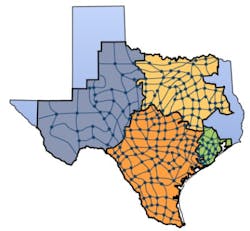ERCOT pilot to analyze impacts of DERs in the Texas Wholesale Grid Market
FERC 2222 is coming to the Lone Star State.
The Electric Reliability Council of Texas, the system operator which manages the state’s grid, has authorized a pilot project to evaluate the participation of aggregated distributed energy resources (DER) in the ERCOT wholesale electricity market. The approval follows the Texas Public Utilities Commission’s directive on studying the impact of DERs into the competitive grid market.
This could eventually open up the inclusion of megawatts (MW) and maybe gigawatts of generation capacity from rooftop solar, residential and business battery storage and microgrids within the Texas system. For now, ERCOT plans to keep limits and controls on the pilot study.
“Initial system-wide participation will be limited to 80 MW of registered capacity ... and 40 MW of Non-Spinning Reserve Service (Non-Spin),” reads the ERCOT document on the project. “These system-wide limits will initially be used to create Load Zone and Qualified Scheduling Entity (QSE) level limits to allow for the opportunity of diverse geographical and technology participation.”
In 2020, the Federal Energy Regulatory Commission, which included Trump Administration appointees from both parties, approved its FERC Order 2222, which focused on removing barriers to aggregated DER assets to participate in all regional whole electric markets. This includes system operators such as PJM Interconnection, ISO-New England, Southwest Power Pool, California ISO and Midcontinent Independent System Operator (MISO).
Some of those ISOs are already implementing phases of the FERC order while others are working through complications. Incorporating intermittent renewables involves unknowns and bi-directional flow challenges to the grid.
Related stories
Ameren Transmission Chair: Short-term Urgency and Long-term Vision needed for Grid Planning
Schneider Electric Innovation Summit: The Future requires Smaller, Faster, Smarter, Cleaner
The ERCOT order comes as Texas adds more and more renewable capacity. The state already is the largest for installed wind power and in the top five for solar, while increasingly considering the impact of battery storage and microgrids (which can include solar, storage and gas-fired generators) on the system.
“Lessons learned from the early phases will be considered when designing additional phases for the Pilot Project that could create opportunities to expand overall participation while maintaining the reliable operation of the transmission and distribution grid,” the ERCOT document reads. “The use of a phased approach will allow for the pilot to commence as early as possible while minimizing changes to ERCOT and Distribution Service Provider (DSP) systems. It allows ERCOT to gain valuable information before making changes to ERCOT rules and systems that may be needed for the longer-term integration of ADERs.”
DER participants which desire to interconnect their generation into the grid must meet ERCOT telemetry and metering accuracy standards. The grid can be endangered when dispatched generation is unpredictable and threatens the frequency range.
The first phase of the ERCOT DER study will look at dispatching and pricing challenges as well as managing congestion on the system. The pilot also will analyze the ability of aggregated DER (ADER) assets to provide primary frequency response services and other potential activities.
The system operator’s ADER Task Force will prepare its Phase 1 report about one year after the first wholesale market offer comes from an aggregated DER participant.
About the Author
Rod Walton, EnergyTech Managing Editor
Managing Editor
For EnergyTech editorial inquiries, please contact Managing Editor Rod Walton at [email protected].
Rod Walton has spent 17 years covering the energy industry as a newspaper and trade journalist. He formerly was energy writer and business editor at the Tulsa World. Later, he spent six years covering the electricity power sector for Pennwell and Clarion Events. He joined Endeavor and EnergyTech in November 2021.
Walton earned his Bachelors degree in journalism from the University of Oklahoma. His career stops include the Moore American, Bartlesville Examiner-Enterprise, Wagoner Tribune and Tulsa World.
EnergyTech is focused on the mission critical and large-scale energy users and their sustainability and resiliency goals. These include the commercial and industrial sectors, as well as the military, universities, data centers and microgrids. The C&I sectors together account for close to 30 percent of greenhouse gas emissions in the U.S.
He was named Managing Editor for Microgrid Knowledge and EnergyTech starting July 1, 2023
Many large-scale energy users such as Fortune 500 companies, and mission-critical users such as military bases, universities, healthcare facilities, public safety and data centers, shifting their energy priorities to reach net-zero carbon goals within the coming decades. These include plans for renewable energy power purchase agreements, but also on-site resiliency projects such as microgrids, combined heat and power, rooftop solar, energy storage, digitalization and building efficiency upgrades.

